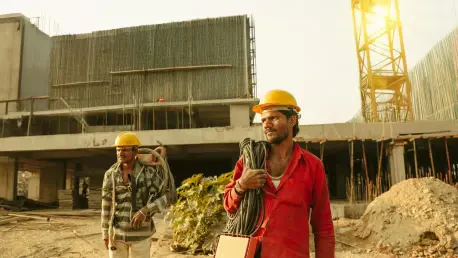The U.S. construction industry, a vital pillar of economic growth, has demonstrated resilience amidst varied and often unpredictable economic conditions. Recently, the sector exhibited astounding growth, evidenced by notable job additions and wage increments. In June, it added 15,000 jobs, primarily in nonresidential construction, while managing to compensate for minor setbacks in heavy and civil engineering. This hiring boost elevated total sector employment to 8.32 million, representing a 1.5 percent rise over the previous year and surpassing the national nonfarm employment growth rate of 1.1 percent. Average hourly wages in construction climbed to $37.20, marking a 4.6 percent increase compared to the previous year and outperforming similar wage growth in the private sector. However, this success faces looming challenges from a dwindling supply of qualified workers, reflected by a significant 33 percent decrease in job openings since last year.
Current Employment Trends
Job Growth Amid Sectoral Divergences
In recent months, significant job growth within the construction industry has been driven by a notable expansion in nonresidential construction. Even amid the growth, the sector experienced slight setbacks with some job losses in heavy and civil engineering. Nonetheless, the overall employment numbers have continued to move upward, indicating a healthy demand for labor and underscoring the sector’s vital contribution to the wider economy. With employment reaching unprecedented levels, the construction industry has outpaced the national growth rate for nonfarm employment, highlighting its robust performance and resilience.
The hike in job opportunities was largely prompted by the expanding needs of urban infrastructures and commercial developments. As cities grow, so does the demand for new office complexes, educational facilities, and residential spaces designed to accommodate expanding populations. Despite strong employment numbers, the industry’s progress is impeded by the glaring challenge of an insufficient workforce. The job openings have seen a precipitous drop; hence, addressing this urgent concern requires targeted strategic efforts to ensure long-term sustainability and growth in this sector.
Wage Growth as a Double-Edged Sword
While job creation presents opportunities, the benefits of this growth are compounded by significant increases in average wages. Construction workers are now receiving an average hourly pay of $37.20, an appreciable rise that outpaces general private sector wage growth. This wage increment has helped attract talent to the industry; however, it also adds pressure on companies navigating financial constraints amid economic fluctuations.
The rise in wages can be partly attributed to the competitive nature of the labor market, where skilled workers are increasingly scarce. To retain the limited pool of qualified workers, construction firms have had to offer better remuneration packages. Yet, this wage increase poses a dilemma, as it contributes to higher operational costs, affecting the bottom lines of many companies. Balancing competitive pay with sustainable financial strategies is therefore crucial in maintaining healthy growth and attracting the workforce necessary for ongoing projects.
Addressing the Labor Shortage
Legislative Measures and Industry Initiatives
One promising avenue to address the current workforce challenge lies in legislative measures that aim to support the construction industry’s growth. Industry leaders maintain hope that tax relief measures being deliberated in the U.S. House of Representatives could ease financial burdens on construction firms. Such policy adjustments could not only invigorate economic activity but also create more opportunities to attract and develop new talent. Additionally, expanding Pell Grant eligibility for short-term credentialing programs could effectively enhance workforce development by facilitating access to skill-enhancing academic opportunities.
The sector requires a multipronged approach to mitigate the labor shortage issue effectively. Encouraging educational paths from high school to vocational training can play a pivotal role in broadening the pipeline of skilled labor entering the market. Modernizing recruitment processes and committing to upskilling existing workers can further alleviate workforce scarcity, ensuring projects can advance without compromising quality or timelines. By implementing these strategies, the industry can bolster its resilience and capacity to meet expanding demands.
Navigating Economic Uncertainties
Navigating economic uncertainties remains a crucial concern given the fluctuating conditions faced by the construction workforce and companies alike. Unpredictable economic signals necessitate adaptive strategies that can cushion the sector against potential downturns. Firms may need to explore innovative technologies and methods to maintain efficiency and competitiveness during periods of labor constraints. Automation and digital solutions could provide alternative means of addressing labor shortages and streamlining operations.
Companies need versatile strategies to thrive amidst shifting economic landscapes, and collaboration across industry stakeholders can yield solutions likely to sustain momentum in the face of adversity. The confluence of technological advancement and strategic planning could pave the way for a more efficient and seamless evolutionary trajectory within the sector. By preparing for economic unpredictability and leveraging innovation, the construction industry can sustain its growth, meeting both present and future infrastructural demands.
Future Considerations and Strategic Insights
In recent months, job growth in the construction industry has surged, driven primarily by an expansion in nonresidential projects. While the sector has experienced some minor setbacks with job losses in heavy and civil engineering, the overall employment figures have continued to increase. This trend reflects a strong demand for labor and underscores the construction sector’s crucial role in the broader economy. Employment has reached record levels, and the industry’s growth rate has exceeded the national average for nonfarm employment, showcasing its strength and resilience.
The boom in job opportunities is largely fueled by the growing needs of urban infrastructure and commercial development. As cities expand, there is a heightened demand for new office complexes, educational institutions, and residential areas to support growing populations. Despite the positive employment numbers, the industry’s progress is hindered by a significant workforce shortage. The number of job openings has surged, emphasizing the need for focused strategic initiatives to ensure the sector’s long-term sustainability and continued growth.









